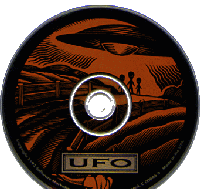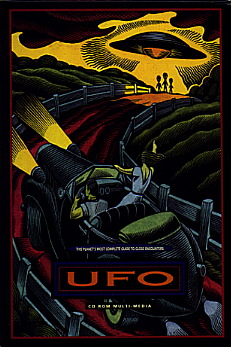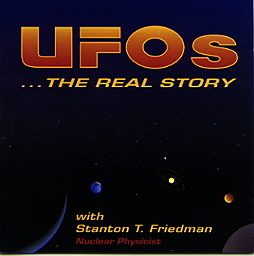MULTIMEDIA CATALOGUES
 Another great application of current computer technology to the management of UFO information
evidence comes from the development of easy-to-be-distributed multimedia catalogues.
Another great application of current computer technology to the management of UFO information
evidence comes from the development of easy-to-be-distributed multimedia catalogues.
Special catalogues of UFO events, such as ITACAT, TRACAT and PHOTOCAT, take a lot of
physical space under the form of paper documents and related imagery. Of course, handling and
distribution of such a huge mass of information is far from being easy and efficient. More, data
exchange among researchers is always difficult, time-consuming and costly. Computer technologies,
again, may offer interesting solutions through an affordable investment. Most database programs may
now handle different kind of information: data, text, images, graphics and even sound and video.
That is just the same kind of stuff researchers have to manage in their nuts and bolts archives.
The idea is to make all of this documentation directly available on a computer screen, where the user
may decide what to see. Imagine to have a card (called "record" in computer jargon) on the monitor
for each reported sighting: all main data about the case are displayed, including original sources.
More, you have references about different documents linked to that same case: newsclippings,
witness' sketches of the reported phenomenon, an abstract of the report, photographs of the sighting
environment or possible ground traces, etc ... Displaying these information on the screen is very
simple: it is enough to point the mouse cursor on a suitable control button and click. You may
imagine the noteworthy advantages coming from such a computer application: to have an on-line
comprehensive documentation of each stored case on a cheap support, able to deliver great flexibility
in data management. Other side benefits are preservation and easy duplication of the collected
documentation, which digital nature may find further use for other projects.
An extension of the concept of a generic database software able to manage different kinds of
documents is the development of a special UFO-oriented program. A brand new multimedia product
will be soon released by myself as a first example of a new way to offer UFO information to all
researchers and buffs. Available on floppy disk (limited edition) or CD-ROM, it delivers a
professionally developed software running under Microsoft Windows on personal computers,
featuring a very attractive and efficient user interface especially designed for such a task.
Three main catalogues of Italian UFO sightings are available through the product: ITACAT (close
encounters), TRACAT (landing trace cases) and PHOTOCAT (photo cases). 
 Each of them comes
with an extensive set of highly defined pictures and sketches, besides all the main data and full
abstracts with comments for most events. More, a general catalogue of Italian sightings (about
10,000) is included together with suitable software for browsing and queries: this allow the
researcher to carry out easily any kind of search on the database. Among the other stuff included in
such a huge work, there is IMAGEBANK (an international collection of UFO-related artworks and
illustrations able to offer a first appreciation of artists' coverage about the theme of "flying saucers"
throughout the years), INTPHOTO (a catalogue with hundreds of alleged UFO photos from all over
the world), a multimedia lecture with a few tens of colourful slides,
Each of them comes
with an extensive set of highly defined pictures and sketches, besides all the main data and full
abstracts with comments for most events. More, a general catalogue of Italian sightings (about
10,000) is included together with suitable software for browsing and queries: this allow the
researcher to carry out easily any kind of search on the database. Among the other stuff included in
such a huge work, there is IMAGEBANK (an international collection of UFO-related artworks and
illustrations able to offer a first appreciation of artists' coverage about the theme of "flying saucers"
throughout the years), INTPHOTO (a catalogue with hundreds of alleged UFO photos from all over
the world), a multimedia lecture with a few tens of colourful slides,  a complete bibliography of
Italian UFO books (including description and cover image of them), a complete presentation of the
Italian Center for UFO Studies publications and a set of statistical graphs plotted on the ground of the
data available through the included UFO sighting catalogue. Among the more than 350 Mbytes of
material making the multimedia project, you may count nearly 2,000 images. Even though mostly
related to the Italian scene, this work delivers a lot of material from everywhere in the world. Its new
way to present and manage available information, makes it something quite different from the other
two UFO CD-ROM now available on the market (others have been announced and will be available
soon), namely Wendelle StevensÆ "UFO - This PlanetÆs most complete guide to close encounters"
(published in 1994) and the interesting Stanton FriedmanÆs "UFOs - The Real Story" (1995).
a complete bibliography of
Italian UFO books (including description and cover image of them), a complete presentation of the
Italian Center for UFO Studies publications and a set of statistical graphs plotted on the ground of the
data available through the included UFO sighting catalogue. Among the more than 350 Mbytes of
material making the multimedia project, you may count nearly 2,000 images. Even though mostly
related to the Italian scene, this work delivers a lot of material from everywhere in the world. Its new
way to present and manage available information, makes it something quite different from the other
two UFO CD-ROM now available on the market (others have been announced and will be available
soon), namely Wendelle StevensÆ "UFO - This PlanetÆs most complete guide to close encounters"
(published in 1994) and the interesting Stanton FriedmanÆs "UFOs - The Real Story" (1995).
A CONCLUSION ....
... may refers to the awareness of having an incredible evidence in our hands, the UFO information,
which is so huge we cannot manage it efficiently. This means that is not fully accessible to the
scientific establishment and UFO researchers as well, reducing its outstanding value. Such an
information is the real unquestionable evidence of the presence of something reported by millions of
people around the world. We must not miss it.
Computer technologies may help us dramatically in making information easily and quickly available
to everybody seriously interested in coping with the UFO question. Switching from a paper-based
archive to an electronic one is not easy and fast for people like ufologists sharing limited resources.
Anyway, the work has been already started and the future will show us the results of such a
revolution. Maybe a dusty file is much more fascinating than a cold piece of hardware filled in with
chips and wires: probably that's true, but progress goes on quickly and all of us need new more
efficient tools to deal with UFO information and related research. Ten years ago, most of the things
reported in this paper looked still somewhere in a distant future. now they aren't. In ten years expect
even more.
Maurizio Verga, May 1995
for the 8th BUFORA International UFO Congress, Sheffield, 19th-20th August, 1995.
NOTES -
Delair J.B., Cox E. & Twine R. (1975-1978) "A provisional catalogue of UFO photographs" UFO REGISTER Vol. 6, n
2 + Vol. 7 n 2 +Vol. 8 n 2
Stevens W. & Roberts A. (1985-86) "UFO Photographs around the World" Vol. 1 & Vol. 2, UFO Photo Archives
Fusco S. & De Turris S. (1975) "Obbiettivo sugli UFO - Fotostoria dei dischi volanti", Edizioni Mediterranee, Italy
International groups or researchers interested in knowing more about PHOTOCAT and exchanging photographs or videos
may write to this author: Maurizio Verga, via Matteotti 85, 22072 Cermenate (Co), ITALY. Phone:+39-31-771600. Please state, if available, a fax number.
A metal-made looking object was seen to fly slowly over some buldings just in front of the witness' house (the mother of
him stated to have seen the object before the son). The young man took two pictures, eight seconds one from the other, by an old Russian camera
he had on a table. Then the object took off vertically at rom the other, by an old Russian camera
he had on a table. Then the object took off vertically at high speed.
This author is available to anybody interested in such a project for consulting or delivering of suitable
information/material.
 BACK TO THE HOME PAGE
ways difficult, time-
BACK TO THE HOME PAGE
ways difficult, time-
 Each of them comes
with an extensive set of highly defined pictures and sketches, besides all the main data and full
abstracts with comments for most events. More, a general catalogue of Italian sightings (about
10,000) is included together with suitable software for browsing and queries: this allow the
researcher to carry out easily any kind of search on the database. Among the other stuff included in
such a huge work, there is IMAGEBANK (an international collection of UFO-related artworks and
illustrations able to offer a first appreciation of artists' coverage about the theme of "flying saucers"
throughout the years), INTPHOTO (a catalogue with hundreds of alleged UFO photos from all over
the world), a multimedia lecture with a few tens of colourful slides,
Each of them comes
with an extensive set of highly defined pictures and sketches, besides all the main data and full
abstracts with comments for most events. More, a general catalogue of Italian sightings (about
10,000) is included together with suitable software for browsing and queries: this allow the
researcher to carry out easily any kind of search on the database. Among the other stuff included in
such a huge work, there is IMAGEBANK (an international collection of UFO-related artworks and
illustrations able to offer a first appreciation of artists' coverage about the theme of "flying saucers"
throughout the years), INTPHOTO (a catalogue with hundreds of alleged UFO photos from all over
the world), a multimedia lecture with a few tens of colourful slides,  a complete bibliography of
Italian UFO books (including description and cover image of them), a complete presentation of the
Italian Center for UFO Studies publications and a set of statistical graphs plotted on the ground of the
data available through the included UFO sighting catalogue. Among the more than 350 Mbytes of
material making the multimedia project, you may count nearly 2,000 images. Even though mostly
related to the Italian scene, this work delivers a lot of material from everywhere in the world. Its new
way to present and manage available information, makes it something quite different from the other
two UFO CD-ROM now available on the market (others have been announced and will be available
soon), namely Wendelle StevensÆ "UFO - This PlanetÆs most complete guide to close encounters"
(published in 1994) and the interesting Stanton FriedmanÆs "UFOs - The Real Story" (1995).
a complete bibliography of
Italian UFO books (including description and cover image of them), a complete presentation of the
Italian Center for UFO Studies publications and a set of statistical graphs plotted on the ground of the
data available through the included UFO sighting catalogue. Among the more than 350 Mbytes of
material making the multimedia project, you may count nearly 2,000 images. Even though mostly
related to the Italian scene, this work delivers a lot of material from everywhere in the world. Its new
way to present and manage available information, makes it something quite different from the other
two UFO CD-ROM now available on the market (others have been announced and will be available
soon), namely Wendelle StevensÆ "UFO - This PlanetÆs most complete guide to close encounters"
(published in 1994) and the interesting Stanton FriedmanÆs "UFOs - The Real Story" (1995). Another great application of current computer technology to the management of UFO information
evidence comes from the development of easy-to-be-distributed multimedia catalogues.
Another great application of current computer technology to the management of UFO information
evidence comes from the development of easy-to-be-distributed multimedia catalogues. BACK TO THE HOME PAGE
ways difficult, time-
BACK TO THE HOME PAGE
ways difficult, time-